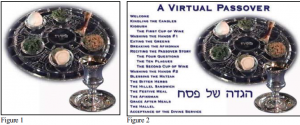Daron L. Janis and Dr. Victor Ludlow, Ancient Scripture
Passover is the central liturgical festival of Judaism, celebrating the Israelite deliverance from Egyptian slavery. It reminds Jews of the birth of their nation and God’s solemn covenant with their ancestors. In fact, Passover has traversed religious boundaries, carrying its significance into both mainstream Christian and Latter-day Saint ideology. However, Passover has always been and will always be a primarily Jewish celebration. It describes the Jewish experience, not only several thousand years ago, but in every generation to the present day and beyond. Indeed, a profound understanding of the social, political, historical, spiritual, and experiential significance of Passover will lead the avid student to a greater understanding of Judaism. The present project is dedicated to providing an educational tool that by using current technologies will aid students in gaining such a profound understanding.
In undertaking the creation of such a tool, there were three stages. The first stage was to gain for myself the type of appreciation and understanding that I am hoping to convey to others. The second stage was to gather the needed resources – i.e. audio/visual footage, software, hardware, images, etc. Finally, the last stage was to actually create the web-based, virtual presentation of Passover. This report will document what has been accomplished to this point and how it has laid a foundation for the final and successful completion of this project.
The realization of the first stage stated above came in several ways. First, I conducted extensive research at the Harold B. Lee Library on any aspect of Passover that I could find. This included historical context for changes that have taken place, spiritual interpretations of the various Passover symbols, differing customs and practices among Jews (i.e. – Sephardim, Ashkenazi, Reform, Reconstructionalist, Orthodox, Hasidic, etc.), and even Jewish folklore. Throughout this process I consulted approximately twenty to thirty different haggadot (the text of the Passover service) and over thirty-five books and articles. I annotated each work and wrote thirty pages of text on the evolution of Passover from the Exodus to the latter days including its use and meaning within the Jewish, Christian, and Latter-day Saint traditions.
I then expanded the sphere of research to synagogues, other major university libraries, and the Spertus Institute of Jewish Studies in Chicago. While in Chicago, I lived with an aunt who teaches in a Reformed synagogue and her husband who teaches History at the University of Illinois. Both have published multiple times. Time and again I found my conversations with them insightful and valuable in obtaining perspective and experience regarding the significance and role that Passover plays in the lives of Jews today.
The realization of the second stage came mainly while I was in Chicago. In two settings, I recorded on digital camcorder my uncle and aunt giving the Passover presentation. Because of the strong Jewish community in Chicago, I was able to purchase essential Passover items that are not available in Utah, such as a seder plate and a kiddush cup (Fig. 1). These items enhanced the aesthetics of the table setting for our recordings. In addition to the video recordings, I also scanned many pictures, images, songs, and recipes that may be incorporated into the final project. Upon returning from Chicago, I purchased a new computer with all the hardware, software, and memory capabilities necessary for doing audio/video editing and web publishing. Thus, I now have all the resources that I need to complete the final stage.
The third stage is yet to be realized although the foundation has been laid now for a successful and exciting completion of the project. The work done in the first two stages has caused my concept of how this project ought to be done to evolve. First, I found that it is essential that I simplify. Originally I planned to have the video playing with scrolling text next to it. This has proved to be impractical and perhaps impossible at this point in time. Also, I had hoped to have the presentation in both English and Hebrew. This proved to be unnecessary. My research has also caused me to rethink the layout and organization of the presentation. For example, I originally planned to organize the presentation into the fourteen general segments of the Passover presentation. At any time, a user would be able to go directly to that point in the presentation. However, many of these segments contain sub-segments that are extremely important and to which a student may wish to go to directly. Therefore, I will need to make sure that these sub-segments are as readily accessible as the traditional segments when I create the layout for the web. An example of a possible home page is shown below (Fig. 2).
What remains to be done on this project are the following: the conversion and editing of all video and audio files into a web-supported format, creating a template for the web layout, incorporation of methods that will make this presentation more user-friendly for students with special needs such as the visually impaired, and the writing of articles that will be linked to the presentation providing the historical, spiritual, social, and political context of the different aspects of Passover.

